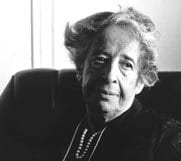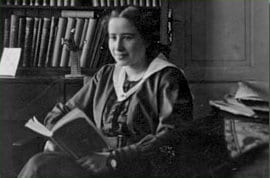Hannah Arendt, born in 1906 in a German Empire, was a Holocaust survivor known worldwide for her extensive contributions that extend across the social sciences, from political economy to psychology. As one of the most influential political theorists of the twentieth century, she is best known for dealing with topics related to the nature of power and evil, and politics, focussing on democracy, authority, and totalitarianism. She studied at the University of Heidelberg under the exstitensialist philosopher Karl Jaspers. In 1933 (the year Adolf Hitler rose to power), she was briefly imprisoned by the Gestapo for her illegal research on antisemitism in Nazi Germany. Upon release, she fled to Czechoslovakia and Switzerland before arriving in Paris, working to help Jewish youth escape to the British Mandate of Palestine. When Germany invaded France in 1940, the French detained her for being an alien. She escaped again to Portugal, where she finally made her way to New York in the United States where she lived for the rest of her life. She became well known after the publication of her first major book The Origins of Totalitarianism in 1951. She spent most of her time in America teaching at many different schools such as Princeton, the University of Chicago, University of California Berkeley, Wesleyan University, and The New School until she died of a heart attack in 1975 at the age of 69.
She criticized social sciences, particularly the failure of it to explain totalitarianism (after her experience in the genocide). What came with the shocking horrors of World War II and the genocide was an overwhelming amount of research trying to explain how such an event can happen and its affects. She believed their social scientific explanations made out of terms of structural theories of causality denied the existence of human freedom. She criticized them for explaining totalitarianism as an exercise of conformity and “group thinking” among other things. Her own theory of totalitarianism can be divided into three major statements. First, the development of totalitarianism in Germany was due to the economic, political, and moral ruination during and after World War I (similar to the development of Bolshevism in the 1930s in Russia after the Bolshevik revolution in 1917). Second, totalitarianism is a combination of shapelessness (what differentiates it from an authoritarian regime) and radicalization. Third, totalitarianism is a peculiar union of terror and ideology. She feels that without these three major components, social scientists cannot properly theorize totalitarianism and she criticizes them for their efforts.

Hannah Arendt in 1975. Source: Wikimedia Commons (Public Domain)
In her next chronological step in her career, Hannah Arendt proposes a theory of what she thought was essential to good human society. In her book, The Human Condition, published in 1958, she proposes three aspects for vita activa (active life and engagement with our world, the factors of our existence): labor, work, and action. Some examples she gives of the human condition is natality (a major theme in all of her political philosophy and social science theories), mortality, worldliness, plurality, and the earth (all fit into vita activa in some way). She believes that the prominence of labor and the dwindling difference between public and private spheres of life is what separates the modern world from Antiquity. She uses this to critique the opinion of ancient social scientists (like Plato and Aristotle), saying their thoughts and theories are outdated. She specifically criticizes their inability to separate philosophy and politics and how heavily they focused on philosophy, asking questions rather than observing their own city, therefore avoiding an active role in their society. She defines labor as something to sustain our existence as animals, using the expression “animal laborans.” She criticizes some political philosophers (like John Locke, Adam Smith and Karl Marx) for misunderstanding labor and its role in society, saying they put too much importance on human laborers, ignoring the other aspects of vita activa. She believes this hinders the possibility of a good human society. Work is labor with an end; it is what makes human beings the maker. She uses the expression “homo famer.” For Arendt, without the distinction between the two, humans are uniquely animals that sustain life, through labor, without building a world, through work. Action, the third part of vita activa, is what makes human beings individuals, though remaining equal to each other. Our acts or deeds and speech, and our freedom to choose, is what makes us humans, more so than work. She sees all of these as necessary for the functioning of human society, and without these three major parts of vita activa, no social thoughts or theories are relevant, especially when considering totalitarianism and its fundamental issues. With this ideology, she lays out a roadmap for how humans should actively participate in a society and how they should be involved in democracy. She argues that only through vita activa can a society fully function. Unsurprisingly so, totalitarianism does not follow the three major parts of vita activia as she lays them out. Despite other major fundamental problems with this society, she believes that vita activa is an important factor in avoiding falling into another controlling regime.
Arendt also raises an interesting point on totalitarianism in her book Eichmann in Jerusalem: A Report on the Banality of Evil, published in 1963. Eichmann was a major organizer of the Holocaust, responsible for the mass deportation of Jews to ghettos and extermination camps. After being captured in Argentina in 1960, he was held on trial in Jerusalem starting in 1961 before finally being executed in 1962. Arendt witnessed his trial, traveling from New York to Jerusalem, which resulted in her book and most controversial political thought: the banality of evil. In this book, she talks about totalitarianism and gives an explanation of how millions of Jews did not rebel during the deportations and evacuations happening in Germany early in the Holocaust: their voices were erased from culture (they were not present on the radio, not seen in theater, not represented in newspapers …). She thinks the same psychological and moral degradation by the Nazi reign applies to Eichmann, who was so filled with the language and code of the Nazi regime; she sees that Eichmann can’t and will not find himself responsible for the deaths of millions of people; he was simply following orders. This raises interesting questions on conformity, group thinking, and propaganda and how they affect social constructs, both in a totalitarian regime and other. She raises the question on how people can do evil things without being evil. She describes Eichmann as “neither perverted nor sadistic”, but “terrifyingly normal.” She believes that he is shallow, clueless, and a “joiner,” falling into the Nazi regime simply in search of purpose and direction, not out of deep ideological belief. She believes that his punishment for his crimes was simply holding him accountable, a punishment, and not revenge, for she felt that you cannot take revenge against someone who did not intend evil things on you. He was simply “following orders.” Arendt’s theory of the banality of evil was highly unpopular, people felt that Eichmann was evil because of his actions, and did not agree with her thoughts behind his intent. They needed him to be Evil. Multiple people even criticized her for lacking “love for the jewish people” (Her good friend, the kabbalah scholar Gershom Scholem).
This theory about Eichmann prompted a lot of research, specifically the Milgram Experiment (1963). This experiment shows how easily people follow authority figures, even to the point of killing people. Many experiments similar to this were released around the same time (end and after World War II). These experiments compliment Hannah Arendt’s point about Eichmann and his inability to feel guilt or responsibility facing what he did and how he simply conformed to the Nazi regime rather than truly act out of belief of the ideology. While experiments like these don’t prove much in the sense of psychology, they allow us to think more critically about human motivation and characteristics, something that Arendt was trying to get us to do through her works.

Young Hannah Arendt (circa 1920). Source: Wikimedia Commons (Public Domain)
It would be interesting to compare her to Jane Addams, who believed in the necessity of direct involvement of society in order to properly theorize and apply social thought. She believed that people needed to see all sides of a society to properly sympathize and understand it. Arendt and Addams had similar thoughts on the need for proper representation of all groups (Arendt’s explanation for the fast and non-rebellious deportation and genocide of the Jewish in early-Holocaust Germany). However, they have contradicting views on how they thought it best to participate in democracy. Arendt says to be human is to actively participate in democracy. Addams on the other hand focussed more on facilitating participation (as in education, language, citizenship for immigrants among other things). While their views are not the same, they could have made a high functioning society if they had the chance to work together. It would have been interesting to see the two women’s thoughts on each other’s work, as well as Addams’ thoughts on totalitarianism and the Jewish genocide in general as well as the high number of immigrants and refugees it created.
Hannah Arendt remains an important figure in both political philosophy and social science thanks to her many contributions and theories to both sciences. She is far from marginalized and her theories are still continually studied in academics, compared with to understand current issues, and used as an example in multiple situations.
About the author:
Marcelle Brooks is a second-year Computer Science major and Creative Writing minor at the University of Chicago. After her Eurocentric High School Education, she was excited to expand more on the ideas of different philosophers.
References:
Featured Image: Hannah Arendt. Source: British Broadcasting Corporation 2020
Arendt, Hannah. The Human Condition. 2nd ed., University of Chicago Press, 2018.
Arendt, Hannah. 2006. Eichmann in Jerusalem: A Report on the Banality of Evil. Penguin Classics, 2006.

